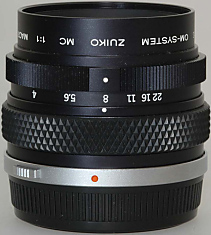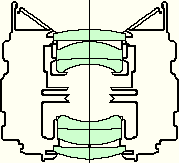Olympus OM system close-up and macro equipment
Zuiko 1:1 Macro Lens 80 mm f/4
Introduction
This is one of the original set of 3 bellows macro lenses for the Olympus OM system and was first produced in 1972. It was the first lens from any manufacturer that was designed for life-size reproduction with a 35mm SLR camera. Unlike nearly all of the other OM lenses, this one has a preset manual diaphragm instead of an automatic one, and so exposure has to be measured with the lens stopped down. Focusing is easier with the aperture wide open. Like the other 2 manual macro lenses, the aperture scale appears upside down when viewed from behind the camera. This is because this lens was expected to be used pointing downwards on a copy stand or a macro stand, so that the scale appears right way up when viewed from the front.
The preset manual diaphragm has 2 rings to control it; a metal ring with click stops and a white dot, and a rubber ring with no click stops and a white dot. The aperture settings are between the 2 rings. To control the aperture:
- Turn the rubber ring so that the iris diaphragm is fully open; its white dot will line up with the number 4.
- Turn the metal ring so that its white dot lines up with the aperture that you want to use; the iris diaphragm will remain open.
- Focus.
- Turn the rubber ring as far as it will go, so that its white dot lines up with the one on the metal ring; this will close down the iris diaphragm.
- Measure the exposure, and/or take the photograph.
The Zuiko 1:1 Macro lens is intended for use with the Auto Bellows, although it can also be used with the Telescopic Auto Tube 65–116 that was introduced in 1980. It can also be used with extension tubes, but with fixed magnifications. It is possible to mount the lens directly on a camera, but it cannot be focused.
This lens was discontinued in 1981, shortly after the introduction of the Zuiko Auto-1:1 Macro 80mm f/4, which has an automatic diaphragm and a helicoid for fine focusing.
Versions
- F.ZUIKO MACRO 1:4 f=80mm (single coated)
- ZUIKO 1:1 MACRO 1:4 f=80mm (? coated) (200xxx, 201xxx)
- ZUIKO MC 1:1 MACRO 1:4 f=80mm (multicoated) (203xxx, 204xxx, 205xxx)
Features
|
|
Magnification range with Auto Bellows
| Lowest magnification | ×0.26 | Subject area | 136.7×91.2 mm | Working distance | 347 mm |
|---|---|---|---|---|---|
| Highest magnification | ×2.3 | Subject area | 15.7×10.4 mm | Working distance | 78 mm |
Accessories
A Mirror Housing was made to fit this lens. A hard leather case was supplied with the lens.
See also: Close-up and Macro Photography – Bellows Macro Lenses
Going digital
This lens has no interaction with the camera body. The manual pre-set mechanism for closing the iris diaphragm works exactly the same on film and digital cameras.
The following tables are based on those in the instruction leaflet, with adjustments for different sensor sizes (smaller sensors reduce the field of view) and for any additional extension needed to allow the release lever on the rear of the Auto Bellows to clear an overhanging pentaprism or flash.
Magnification and field of view for Auto Bellows with Canon EOS 5D MkII
36×24 mm sensor, with 7 mm extension tube between bellows and OM/EOS adapter
| Magnification | 0.4 | 0.5 | 0.6 | 0.7 | 0.8 | 0.9 | 1.0 | 1.2 | 1.4 | 1.6 | 1.8 | 2.0 | 2.2 | 2.4 |
|---|---|---|---|---|---|---|---|---|---|---|---|---|---|---|
| Subject area (mm) | 90 × 60 | 72 × 48 | 60 × 40 | 51.4 × 34.3 | 45 × 30 | 40 × 26.7 | 36 × 24 | 30 × 20 | 25.7 × 17.1 | 22.5 × 15 | 20 × 13.3 | 18 × 12 | 16.4 × 10.9 | 15 × 10 |
| Bellows scale* (mm) | 72 | 80 | 88 | 96 | 104 | 112 | 120 | 136 | 152 | 168 | 184 | 200 | 216 | 224 |
| Lens to subject distance (cm) | 24.3 | 20.3 | 17.6 | 15.7 | 14.3 | 13.2 | 12.3 | 11.0 | 10.0 | 9.3 | 8.8 | 8.3 | 8.0 | 7.8 |
Magnification and field of view for Auto Bellows with Canon EOS 40D
22.2×14.8 mm APS-C sensor, with 14 mm extension tube between bellows and OM/EOS adapter
| Magnification | 0.5 | 0.6 | 0.7 | 0.8 | 0.9 | 1.0 | 1.2 | 1.4 | 1.6 | 1.8 | 2.0 | 2.2 | 2.4 |
|---|---|---|---|---|---|---|---|---|---|---|---|---|---|
| Subject area (mm) | 44.4 × 29.6 | 37.0 × 24.7 | 31.7 × 21.1 | 27.75 × 18.5 | 24.7 × 16.4 | 22.2 × 14.8 | 18.5 × 12.3 | 15.9 × 10.6 | 13.9 × 9.25 | 12.3 × 8.2 | 11.1 × 7.4 | 10.1 × 6.7 | 9.25 × 6.2 |
| Bellows scale* (mm) | 73 | 81 | 89 | 97 | 105 | 113 | 129 | 145 | 161 | 177 | 193 | 209 | 217 |
| Lens to subject distance (cm) | 20.3 | 17.6 | 15.7 | 14.3 | 13.2 | 12.3 | 11.0 | 10.0 | 9.3 | 8.8 | 8.3 | 8.0 | 7.8 |
Magnification and field of view for Auto Bellows with Olympus E-1, E-300, E-330 and Micro Four Thirds
17.3×13.0 mm Four-Thirds sensor, with no extension tube between bellows and OM/Four Thirds adapter
| Magnification | 0.4 | 0.5 | 0.6 | 0.7 | 0.8 | 0.9 | 1.0 | 1.2 | 1.4 | 1.6 | 1.8 | 2.0 | 2.2 | 2.4 |
|---|---|---|---|---|---|---|---|---|---|---|---|---|---|---|
| Subject area (mm) | 43.25 × 32.5 | 34.6 × 26.0 | 28.8 × 21.7 | 24.7 × 18.6 | 21.6 × 16.25 | 19.2 × 14.4 | 17.3 × 13.0 | 14.4 × 10.8 | 12.4 × 9.3 | 10.8 × 8.1 | 9.6 × 7.2 | 8.65 × 6.5 | 7.9 × 5.9 | 7.2 × 5.4 |
| Bellows scale* (mm) | 79 | 87 | 95 | 103 | 111 | 119 | 127 | 143 | 159 | 175 | 191 | 207 | 223 | 231 |
| Lens to subject distance (cm) | 24.3 | 20.3 | 17.6 | 15.7 | 14.3 | 13.2 | 12.3 | 11.0 | 10.0 | 9.3 | 8.8 | 8.3 | 8.0 | 7.8 |
Magnification and field of view for Auto Bellows with Olympus E-3, E-410, E-500, E-510, E-620
17.3×13.0 mm Four-Thirds sensor, with 7 mm extension tube between bellows and OM/Four Thirds adapter
| Magnification | 0.4 | 0.5 | 0.6 | 0.7 | 0.8 | 0.9 | 1.0 | 1.2 | 1.4 | 1.6 | 1.8 | 2.0 | 2.2 | 2.4 |
|---|---|---|---|---|---|---|---|---|---|---|---|---|---|---|
| Subject area (mm) | 43.25 × 32.5 | 34.6 × 26.0 | 28.8 × 21.7 | 24.7 × 18.6 | 21.6 × 16.25 | 19.2 × 14.4 | 17.3 × 13.0 | 14.4 × 10.8 | 12.4 × 9.3 | 10.8 × 8.1 | 9.6 × 7.2 | 8.65 × 6.5 | 7.9 × 5.9 | 7.2 × 5.4 |
| Bellows scale* (mm) | 72 | 80 | 88 | 96 | 104 | 112 | 120 | 136 | 152 | 168 | 184 | 200 | 216 | 224 |
| Lens to subject distance (cm) | 24.3 | 20.3 | 17.6 | 15.7 | 14.3 | 13.2 | 12.3 | 11.0 | 10.0 | 9.3 | 8.8 | 8.3 | 8.0 | 7.8 |
* The bellows scale should be read at the rear of the body mount, with the lens mount positioned at the front end of the rail.
Instruction leaflet
CLOSE-UP & MACROPHOTOGRAPHY TABLE (With Auto Bellows)
| Subject Area Covered mm | 120 × 80 | 90 × 60 | 72 × 48 | 60 × 40 | 51.4 × 34.3 | 45 × 30 | 40 × 26.7 | 36 × 24 | 30 × 20 | 25.7 × 17.1 | 22.5 × 15 | 20 × 13.3 | 18 × 12 | 16.4 × 10.9 | 15 × 10 | |
|---|---|---|---|---|---|---|---|---|---|---|---|---|---|---|---|---|
| Magnification | 0.3 | 0.4 | 0.5 | 0.6 | 0.7 | 0.8 | 0.9 | 1.0 | 1.2 | 1.4 | 1.6 | 1.8 | 2.0 | 2.2 | 2.4 | |
| Scale (mm) | 68 | 71 | 79 | 87 | 95 | 103 | 111 | 119 | 127 | 143 | 159 | 175 | 191 | 207 | 223 | 231 |
| Lens vertex-to-subject distance (cm) | 34.7 | 31.0 | 24.3 | 20.3 | 17.6 | 15.7 | 14.3 | 13.2 | 12.3 | 11.0 | 10.0 | 9.3 | 8.8 | 8.3 | 8.0 | 7.8 |
CLOSE-UP AND MACROPHOTOGRAPHY TABLE (With Auto Bellows)
| Subject Area Covered (in) | 3 35/64 × 2 23/64 | 2 23/64 × 1 37/64 | 1 49/64 × 1 3/16 | 1 27/64 × 15/16 | 1 1/64 × 43/64 | 25/32 × 17/32 | 41/64 × 27/64 | |||||||||
|---|---|---|---|---|---|---|---|---|---|---|---|---|---|---|---|---|
| Magnification | 0.3 | 0.4 | 0.5 | 0.6 | 0.7 | 0.8 | 0.9 | 1.0 | 1.2 | 1.4 | 1.6 | 1.8 | 2.0 | 2.2 | 2.4 | |
| Scale (mm) | 68 | 71 | 79 | 87 | 95 | 103 | 111 | 119 | 127 | 143 | 159 | 175 | 191 | 207 | 223 | 231 |
| Distance from lens to subject (in) | 13 11/64 | 12 13/64 | 9 9/16 | 7 63/64 | 6 59/64 | 6 3/16 | 5 5/8 | 5 13/64 | 4 27/32 | 4 21/64 | 3 15/16 | 3 21/32 | 3 15/32 | 3 17/64 | 3 5/32 | 3 5/64 |
OLYMPUS
OLYMPUS OPTICAL CO. LTD.
43-2 Hatagaya 2-chome, Shibuya-ku, Tokyo, Japan
Exploded parts diagram
Send comments or questions to Alan Wood
![]()
Created 18th May 2001 — Updated 28th February 2021
Copyright © 2001–2021 Alan Wood

